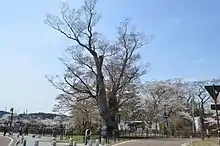Tanagura Domain
Tanagura Domain (棚倉藩, Tanagura-han) was a fudai feudal domain under the Tokugawa shogunate of Edo period Japan. It is located in southern Mutsu Province, Honshū. The domain was centered at Tanagura Castle, located in what is now part of the town of Tanagura in Fukushima Prefecture.
| Tanagura Domain 棚倉藩 | |
|---|---|
| under Tokugawa shogunate Japan | |
| 1603–1871 | |
| Capital | Tanagura Castle |
| Area | |
| • Coordinates | 37°1′46.89″N 140°23′8.29″E |
| • Type | Daimyō |
| Historical era | Edo period |
• Established | 1603 |
• Disestablished | 1871 |
| Today part of | part of Fukushima Prefecture |

History
During the Sengoku period, Tanagura was an outpost of the Satake clan, who built the mountain-top Akadake Castle near what would later become Tanagura Castle. After the Satake were defeated and transferred to Dewa Province by Tokugawa Ieyasu, the area was awarded to Tachibana Muneshige. Following the Siege of Osaka, the domain was awarded to Niwa Nagashige, who was ordered to build a completely new castle by Shōgun Tokugawa Hidetada. The Niwa were followed by the Naitō clan, who continued to develop the castle and its surrounding castle town; however, under the Tokugawa shogunate the domain saw frequent changes of daimyō.
During the Bakumatsu period, Matsudaira Yasuhide was transferred to Kawagoe Domain, and Abe Masakiyo was transferred from neighbouring Shirakawa Domain. During the Boshin War, the domain was a member of the pro-Tokugawa Ōuetsu Reppan Dōmei, but fell to imperial forces in 1868 after only one day of fighting. In July 1871, with the abolition of the han system, Tanagura Domain briefly became Tanagura Prefecture, and was merged into the newly created Fukushima Prefecture. Under the new Meiji government, Abe Masakoto, the final daimyō of Tanagura Domain was given the kazoku peerage title of shishaku (viscount).
Bakumatsu period holdings
As with most domains in the han system, Tanagura Domain consisted of several discontinuous territories calculated to provide the assigned kokudaka, based on periodic cadastral surveys and projected agricultural yields.[1][2]
- Mutsu Province (Iwaki Province)
- 62 villages in Shirakawa District
- 26 villages in Kikuta District
- 15 villages in Naraha District
- 3 villages in Iwasaki District
- 1 village in Iwaki District
- Mutsu Province (Iwashiro Province)
- 26 villages in Date District
- 2 villages in Shinobu District
- Dewa Province (Uzen Province)
- 12 villages in Murayama District
- Harima Province
- 18 villages in Katō District
List of daimyōs
| # | Name | Tenure | Courtesy title | Court Rank | kokudaka | Notes |
|---|---|---|---|---|---|---|
| 1 | Tachibana Muneshige (立花宗茂) | 1603–1620 | Sakon-no-jo (左近将監); Jijū (侍従) | Lower 4th (従四位下) | 10,000→25,500→35,000 koku | transfer to Yanagawa Domain |
| 1 | Niwa Nagashige (丹羽長重) | 1622–1627 | Kaga-no-kami (加賀守); Jijū (侍従) | 3rd (従三位下) | 50,000 koku | transfer to Shirakawa Domain |
| 1 | Naitō Nobuteru (内藤信照) | 1627–1665 | Buzen-no-kami (豊前守) | Lower 5th (従五位下) | 70,000 koku | |
| 2 | Naitō Nobuyoshi (内藤信良) | 1665–1674 | Buzen-no-kami (豊前守) | Lower 5th (従五位下) | 70,000 koku | |
| 3 | Naitō Kazunobu (内藤弌信) | 1673–1705 | Buzen-no-kami (豊前守) | Lower 4th (従四位下) | 70,000 koku | transfer to Tanaka Domain |
| 1 | Ōta Sukeharu (太田資晴) | 1705–1728 | Bitchu-no-kami (備中守) | Lower 4th (従四位下) | 50,000 koku | transfer to Tatebayashi Domain |
| 1 | Matsudaira Takechika (松平武元) | 1728–1746 | Ukon-no-jo (右近将監); Jijū (侍従) | Lower 4th (従四位下) | 65,000 koku | |
| 1 | Ogasawara Nagayuki (小笠原長恭) | 1746–1776 | Sado-no-kami (佐渡守) | Lower 5th (従五位下) | 65,000 koku | |
| 2 | Ogasawara Nagataka (小笠原長堯) | 1776–1812 | Sado-no-kami (佐渡守) | Lower 5th (従五位下) | 65,000 koku | |
| 3 | Ogasawara Nagamasa (小笠原長昌) | 1812–1817 | Sado-no-kami (佐渡守) | Lower 5th (従五位下) | 65,000 koku | transfer to Karasu Domain |
| 1 | Inoue Masamoto (井上正甫) | 1817–1820 | Kawachi-no-kami (河内守) | Lower 5th (従五位下) | 60,000 koku | |
| 2 | Inoue Masaharu (井上正春) | 1820–1836 | Kawachi-no-kami (河内守); Jijū (侍従) | Lower 4th (従四位下) | 60,000 koku | transfer to Tatebayashi Domain |
| 1 | Matsudaira Yasutaka (松平康爵) | 1836–1854 | Sakon-no-jo (右近将監) | Lower 5th (従五位下) | 60,000 koku | |
| 2 | Matsudaira Yasukado (松平康圭) | 1854–1862 | Suwo-no-kami (周防守) | Lower 5th (従五位下) | 60,000 koku | |
| 3 | Matsudaira Yasuhiro (松平康泰) | 1862–1864 | Suwo-no-kami (周防守) | Lower 5th (従五位下) | 60,000 koku | |
| 4 | Matsudaira Yasuhide (松平康英) | 1864–1866 | Suwo-no-kami (周防守) | Lower 5th (従五位下) | 60,000 koku | transfer to Kawagoe Domain |
| 1 | Abe Masakiyo (阿部正静) | 1866–1868 | Mimasaka-no-kami (美作守) | Lower 5th (従五位下) | 100,000 -> 60,000 koku | |
| 2 | Abe Masakoto (阿部正功) | 1868–1871 | - none - | -none - | 60,000 koku | |
See also
- List of Han
Notes
- Mass, Jeffrey P. and William B. Hauser. (1987). The Bakufu in Japanese History, p. 150.
- Elison, George and Bardwell L. Smith (1987). Warlords, Artists, & Commoners: Japan in the Sixteenth Century, p. 18.
References
- The content of this article was largely derived from that of the corresponding article on Japanese Wikipedia.
- Papinot, E (1910). Historical and Geographic Dictionary of Japan. Tuttle (reprint) 1972.
External links
- (in Japanese) Tanagura on "Edo 300 HTML" (9 Oct. 2007)